If you want to have a guide to know how to get mobile internet in Curacao, here you can learn everyt...
Mobile Internet
Planning a trip to Spain? Staying connected is easier than ever with three main options: Travel Passes for quick setup, local SIM cards for budget-friendly high-speed data, and eSIMs like Holafly for instant digital access.

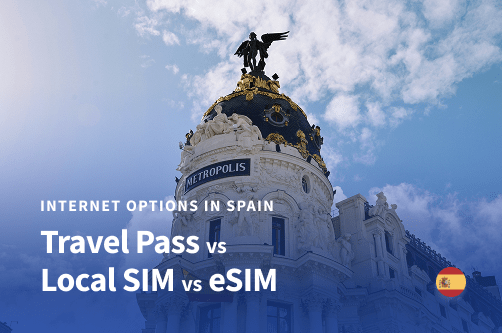
Planning your itinerary for Spain? Staying connected is one of the first things you’ll want to sort out. The good news is, you have several options, each with its own pros and cons depending on your travel style, budget, and length of stay.
Here’s a quick look at your three main choices:
Each option has its trade-offs, and below we’ll compare costs, convenience, and best use cases to help you choose the right one for your trip to Spain.
Your mobile data usage depends on how you spend your time online. Apps like maps and messaging require very little, while streaming videos or joining video calls can eat through gigabytes quickly.
Travelers generally fall into two categories: those who only need a small daily amount to stay connected, and those who rely heavily on data for work or entertainment. Knowing where you fit makes it much easier to pick the right plan.
For this guide, we’ll consider:
Here’s a table that shows the average data usage of popular apps per hour, so you can better estimate your needs.
| App | 1 hour usage | Impact on data |
| Google Maps | 3–5 MB | Negligible use |
| Spotify | 144 MB | Light usage |
| YouTube | 1.5 GB | Very heavy |
| Netflix | 1 GB | Heavy |
| WhatsApp video | ~900 MB | Heavy |
| Zoom | ~900 MB | Heavy |
| ~600 MB | Moderate | |
| TikTok | 750 MB – 1 GB | Heavy |
| Google Drive video | 300 MB (low quality) | Moderate |
After looking at how much data common apps use, it’s easier to see whether you’re closer to a light user or a heavy user. Let’s make things easier to understand by comparing two travelers with very different data needs, named Nina and Leo.
Nina is a nurse from Toronto taking a well-deserved break during the best time to visit Spain. She’s here to unwind, wander through museums, and enjoy tapas without being glued to her phone. She mainly uses data for music, maps, and the occasional post to update friends back home.
Nina’s typical day:
Nina’s daily total: ≈ 950 MB
Leo is a university student from Alaska spending the summer in Spain while finishing an online course. Between lectures on Zoom, uploading assignments, and documenting his trip for his growing TikTok channel, he needs a strong and steady connection every day.
Leo’s power-user day:
Leo’s daily total: ≈ 3 GB
Now imagine both are on a 10-day trip, traveling from Barcelona to Madrid with stops in Seville and Valencia. Their data needs couldn’t be more different:
| Traveler type | Daily usage | 10-day trip total |
| Nina (light user) | ~950 MB | 8–10 GB |
| Leo (heavy user) | ~3 GB | ~30 GB |
This contrast shows why it’s so important to match your plan to your habits. Nina could save money with a smaller package, while Leo would need a high-capacity or unlimited plan to avoid running into limits.
With Nina’s and Leo’s profiles in mind, let’s compare the three main ways to stay connected in Italy: a Travel Pass (roaming), a local SIM card, and an eSIM. For each, we’ll cover pricing, data limits, pros and cons, and who it’s best for. We’ll start with the Travel Pass.
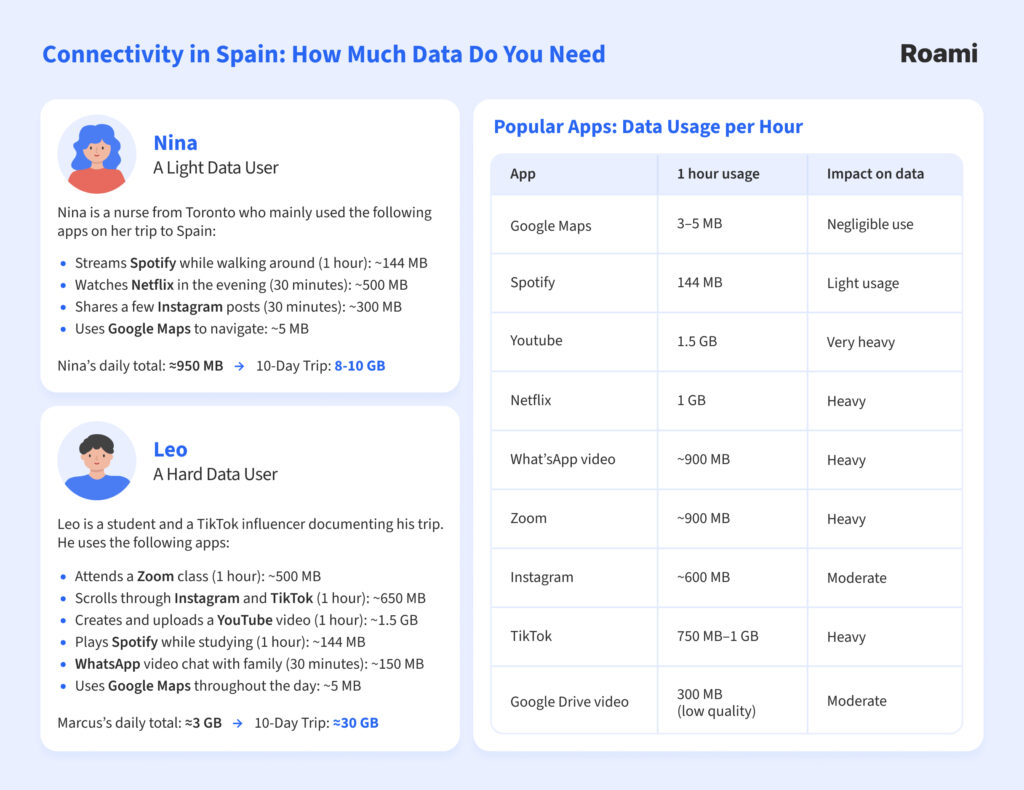
A Travel Pass is a prepaid bundle from carriers like AT&T and Verizon that lets you use your phone abroad for a fixed daily rate. It usually includes data, calls, and texts, working much like your regular plan but with international coverage.
Pros of a Travel Pass:
Cons of a Travel Pass:
To give you a clearer understanding of Travel Passes, let’s look at Verizon TravelPass.
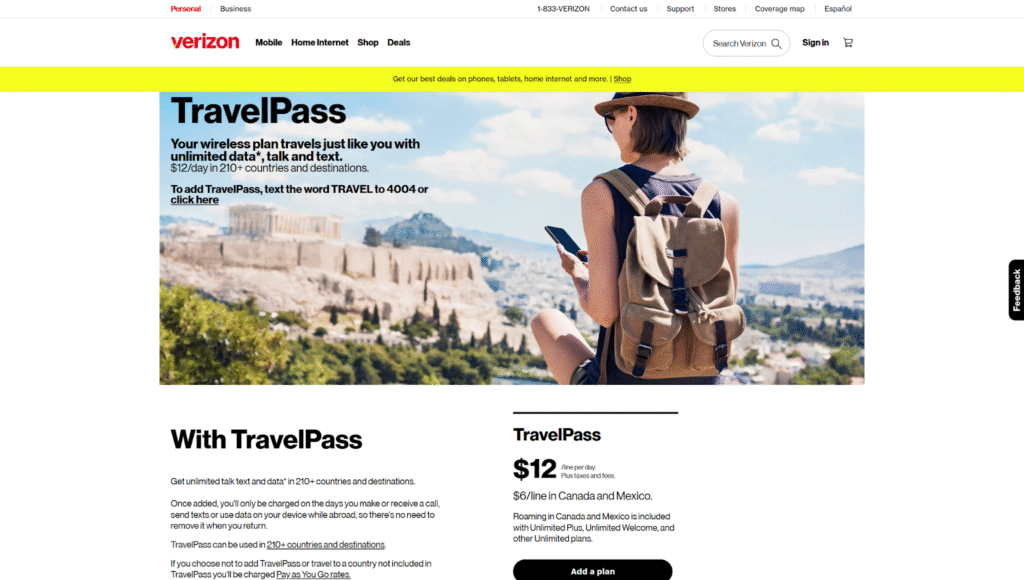
Source: Verizon TravelPass website.
Verizon TravelPass provides unlimited data, calls, and texts in 210+ destinations, including Spain, at $12 per day per line. After the first 5 GB of high-speed data, usage continues with unlimited data at reduced 3G speeds for the rest of the TravelPass session.
On the other hand, you can also avail of Verizon’s International Monthly Plan for data roaming, which includes unlimited data allowance, 250 minutes, and unlimited texts in 210+ destinations, at $100 per month per line. After the first 20 GB of high-speed data, you’ll have unlimited data at 3G speeds. Calls beyond your allowance cost $0.25 per minute.
| Plan | Data | Calls/texts | Price | Price for 10-day trip |
| TravelPass | 5 GB high-speed/day, then unlimited at 3G | Unlimited calls & texts | $12/day per line | $120 per line |
| International Monthly Plan | 20 GB high-speed, then unlimited at 3G | 250 minutes, unlimited texts | $100/month per line | $100 per line |
Your plan starts automatically when you use your phone with roaming turned on when abroad. Each 24-hour session begins with phone activity, and you’ll be notified when it ends.
For a Spain trip, Nina (≈10 GB total for 10 days) would be fine on the monthly plan, since her usage fits comfortably within the 20 GB allowance. It will also be $20 cheaper compared to TravelPass.
Leo (≈30 GB in 10 days), however, would quickly burn through the cap of the monthly plan. For him, TravelPass makes more sense, since its daily reset means he could keep using high-speed data every day, even though the total cost is higher.
The Verdict: TravelPass is ideal for heavy users like Leo who need extensive, daily high-speed data, while lighter users like Nina can save money with the International Monthly Plan.
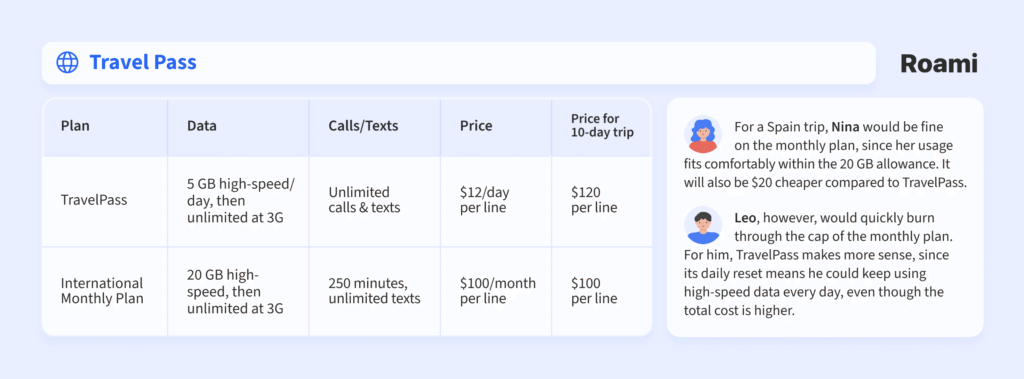
Buying a local SIM card in Spain is a simple way to get online, often at much lower costs than international roaming. With a Spanish SIM, you get access to local networks, larger data allowances, and a local phone number for calls and texts.
You can buy a SIM once you arrive at an airport kiosk, carrier store, supermarket, or electronics shop. Some travelers also choose to preorder a SIM online so they can start using mobile data as soon as they land. A passport is usually required for registration, and activation is needed before use.
Pros of local SIMs:
Cons of local SIMs:
| Provider | Data | Calls/texts | Duration | Price |
| Movistar | 10 GB + 40 GB 5G | Unlimited national, 200 min international | 28 days | ~$11 |
| 20 GB + 80 GB 5G | Unlimited national, 400 min international | 28 days | ~$17 | |
| 35 GB + 140 GB 5G | Unlimited national | 28 days | ~$22 | |
| Orange | 5 GB | 30 international min, 120 worldwide SMS | 15 days | $15 |
| 10 GB | 60 international min, 180 worldwide SMS | 30 days | $23 | |
| 20 GB | 120 international min, 200 worldwide SMS | 30 days | $27 | |
| Vodafone | 240 GB | 2,000 international min | 28 days | ~$17 |
| 300 GB | 3000 international min | 28 days | ~$23 | |
| Yoigo | 25 GB | Unlimited local calls | 30 days | ~$12 |
| 50 GB | Unlimited local calls | 30 days | ~$17 | |
| 100 GB | Unlimited local calls | 30 days | ~$23 |
Local SIMs are the best choice for travelers who want high-speed data at low prices, especially for longer trips or heavy users. However, if you want instant connectivity or a simpler setup, an eSIM or TravelPass might be more convenient.
The Verdict: Local SIM cards are a cost-effective way to stay connected in Spain. For Nina, the Movistar 10 GB + 40 GB 5G plan gives enough data for messaging, navigation, and light streaming without overspending.
Leo, who needs more bandwidth for video calls and content uploads, would benefit from the Vodafone Prepago XL 350 GB plan, ensuring he won’t run out of data during his trip. Local SIMs offer excellent value, but do require a bit of setup after arrival.
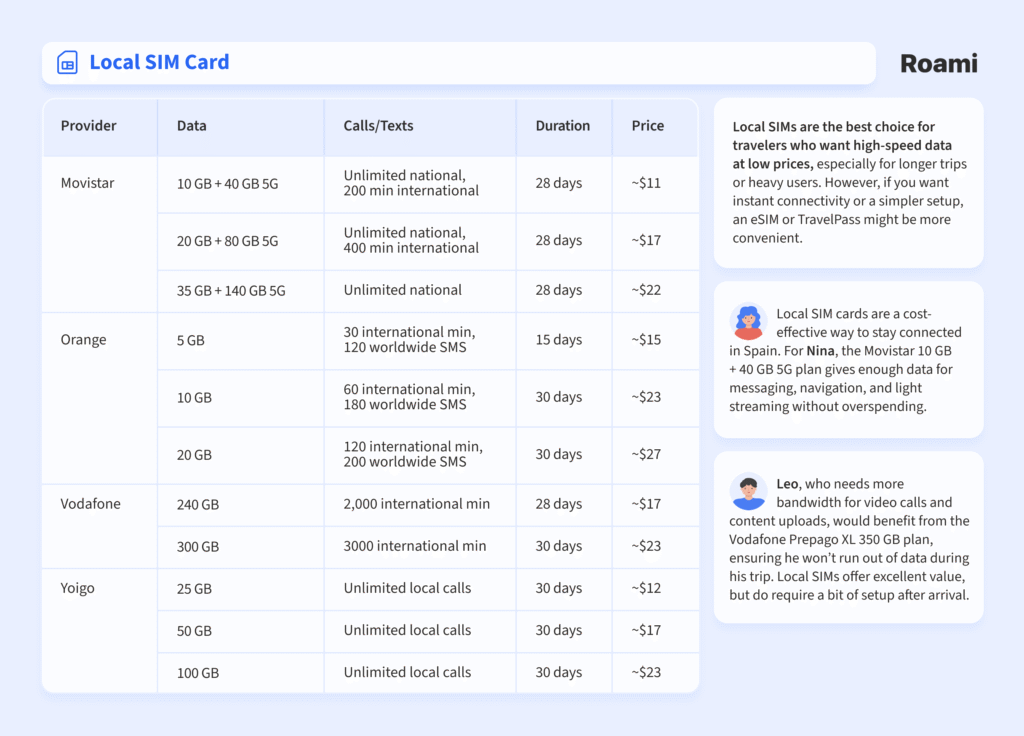
Another way to stay connected in Spain is with an eSIM, a digital SIM built into your phone. Instead of buying a physical card, you can purchase a plan online, scan an eSIM QR code, and start using data immediately.
eSIMs are ideal for travelers who want internet access the moment they land. However, they do have some limitations as not all phones support eSIMs, and most plans are data-only without calls or texts.
Pros of eSIMs:
Cons of eSIMs:
The Verdict: eSIMs offer the most convenience and flexibility. Travelers like Nina who need basic internet will find budget-friendly options like Airalo sufficient. At the same time, heavy users like Leo can opt for unlimited data plans from providers like Holafly to stay fully connected.
When deciding on the best eSIM for Spain, the following providers stand out for the following factors: data allowance, plan flexibility, coverage, and pricing.
Below is a breakdown of each provider, including info on customer support and refund policies.
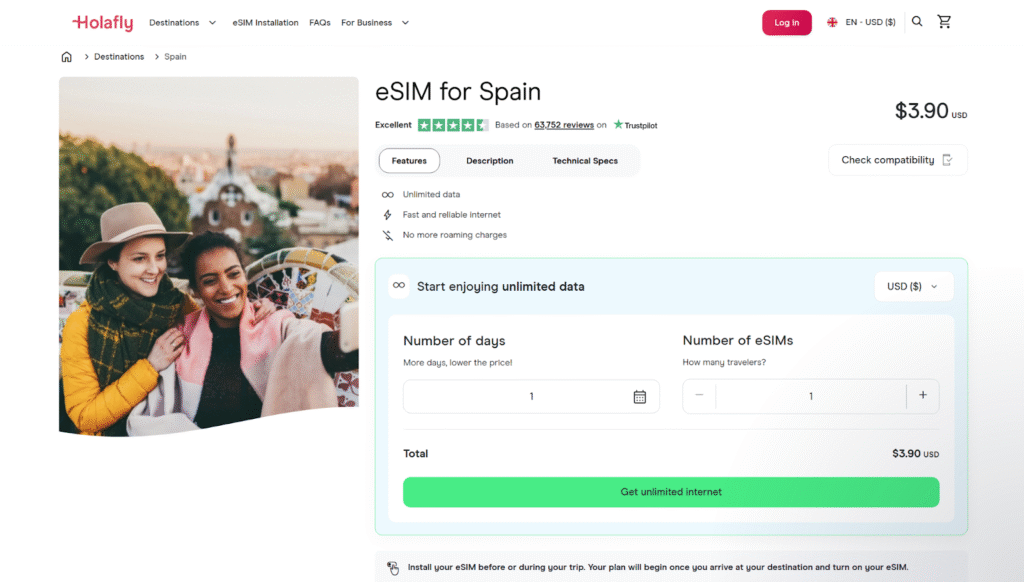
Holafly offers unlimited data plans that can be adjusted from 1 to 90 days, making it ideal for heavy travelers who need uninterrupted internet. Holafly also provides 24/7 customer support, so you can always find assistance when you need it.
Holafly’s refund policy gives you up to six months to request a refund.
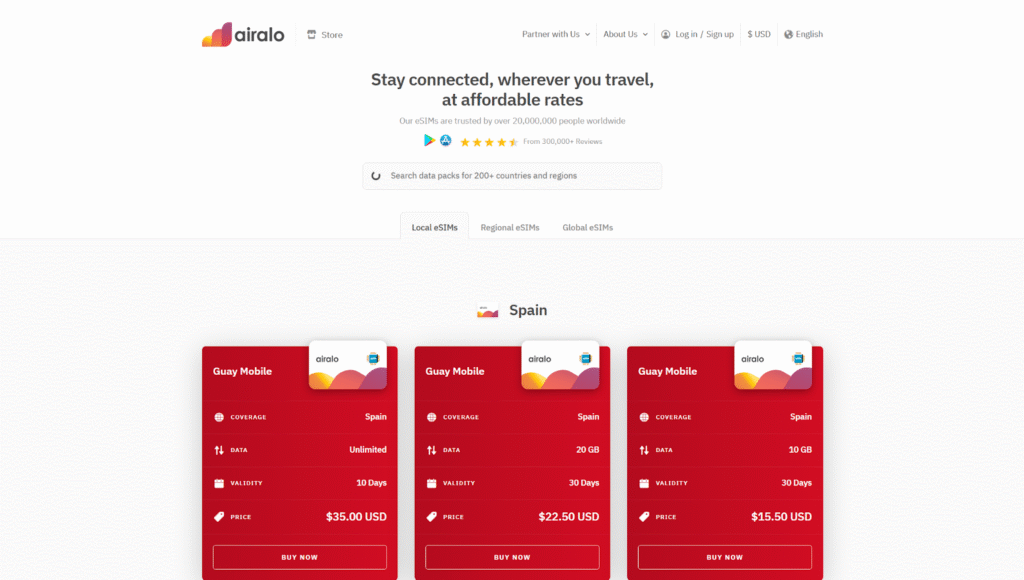
Airalo provides a wide range of prepaid data plans for Spain, from 1 GB for 7 days to unlimited data for 10 days. Airalo works with major local networks and offers flexible plans for light or moderate data users.
Airalo refunds, partial or full, are offered on eSIMs under certain conditions within 30 days of purchase.
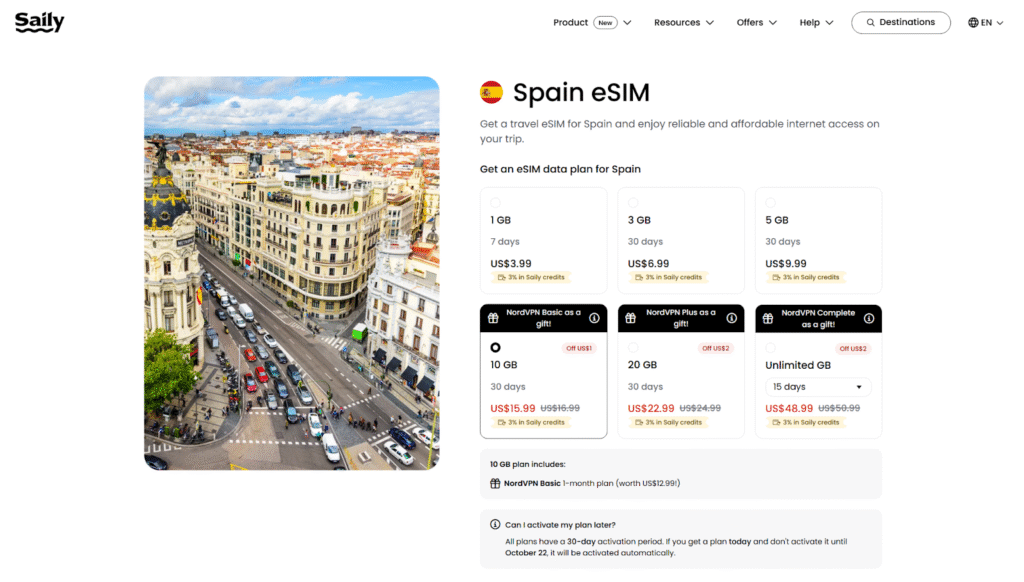
Saily’s eSIMs cover a spectrum of needs, from 1 GB for 7 days to unlimited data for 15–30 days, making it suitable for both light and heavy users. Plans often include perks like bonus VPN access or Saily credits.
As per Saily’s refund policy, you must request your refund within 30 days of purchase.
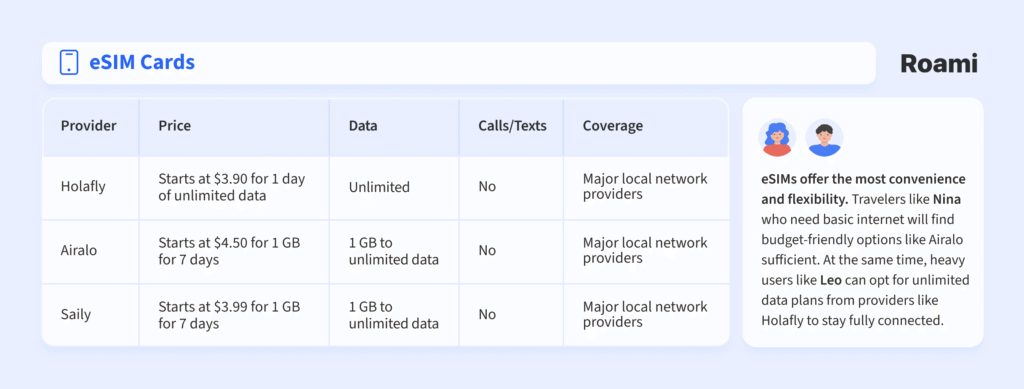
Choosing the right way to stay connected in Spain depends on your trip, how much data you use, and how you prefer to manage your connection. Here’s a quick look at your main options:
| Option | Data & price | Convenience | Calls and texts | Setup | Best for |
| Travel Pass | $12/day → 5 GB/day high speed, then 3G | Works instantly | Yes, keeps your number | Auto-activates | activatesShort trips, simple setup |
| Local SIM | €15–€30 → 25–350 GB for 28–30 days | Must buy & register in Spain | Yes, varies by plan | Passport + SIM swap | Longer stays, heavy data, budget-conscious travelers |
| eSIM (Holafly) | $3.90/day → unlimited, adjustable 1–90 days | Instant setup before/after arrival | Mostly data-only | Scan QR, activate digitally | Flexible users, remote workers, and travelers who want connectivity from Day 1 |
How to choose:
For Nina, a light user, a smaller eSIM or even a Travel Pass works well. For Leo, who’s streaming, uploading, and video calling daily, Holafly’s unlimited eSIM is the easiest way to stay fully connected without worrying about limits.


